HI6028 Taxation Law: Australian Income Tax Rules and Tax Liability
VerifiedAdded on 2024/05/29
|11
|2953
|458
Report
AI Summary
This report provides an analysis of Australian income tax rules applicable to RIP Pty Limited, a funeral services company, addressing its tax liability and compliance. It examines the Arthur Murray V FCT case to determine the assessable income concerning advance payments and unclaimed amounts under the Easy Funeral Plans. The report advises on the tax treatment of stock purchases, dividends, rental payments, director's payments, and construction expenses. It clarifies that stock items are those purchased for sale or production, and their purchase is a deductible business expense. Fully franked dividends are tax-exempt, and rental payments are expensed in the related year, with prepaid amounts treated as capital expenditure. The report emphasizes the importance of adhering to income tax rules for accurate financial recording and legal compliance, offering guidance to the management of RIP Pty Limited on navigating complex taxation issues.
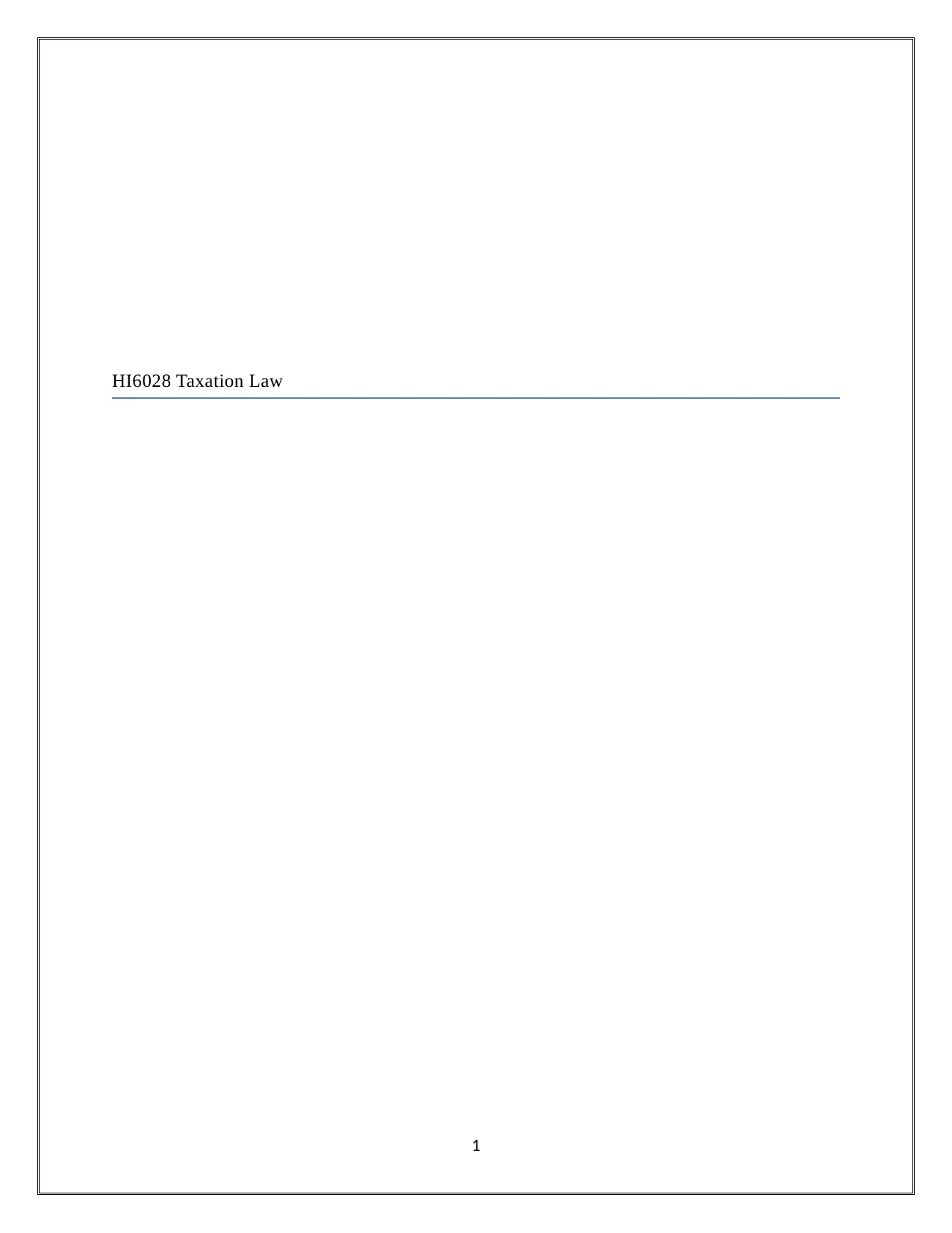
HI6028 Taxation Law
1
1
Paraphrase This Document
Need a fresh take? Get an instant paraphrase of this document with our AI Paraphraser
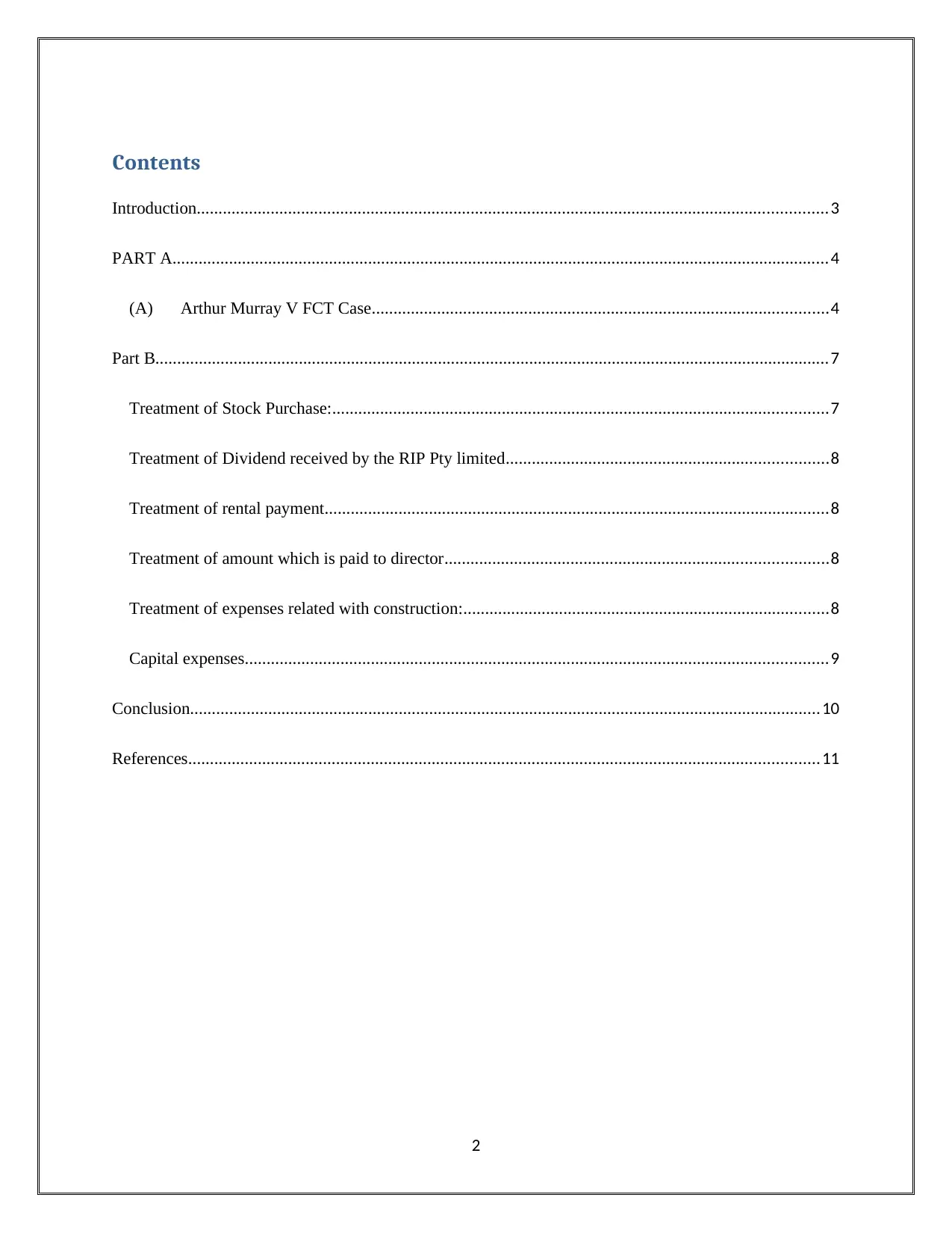
Contents
Introduction.................................................................................................................................................3
PART A.......................................................................................................................................................4
(A) Arthur Murray V FCT Case.........................................................................................................4
Part B...........................................................................................................................................................7
Treatment of Stock Purchase:..................................................................................................................7
Treatment of Dividend received by the RIP Pty limited..........................................................................8
Treatment of rental payment....................................................................................................................8
Treatment of amount which is paid to director........................................................................................8
Treatment of expenses related with construction:....................................................................................8
Capital expenses......................................................................................................................................9
Conclusion.................................................................................................................................................10
References.................................................................................................................................................11
2
Introduction.................................................................................................................................................3
PART A.......................................................................................................................................................4
(A) Arthur Murray V FCT Case.........................................................................................................4
Part B...........................................................................................................................................................7
Treatment of Stock Purchase:..................................................................................................................7
Treatment of Dividend received by the RIP Pty limited..........................................................................8
Treatment of rental payment....................................................................................................................8
Treatment of amount which is paid to director........................................................................................8
Treatment of expenses related with construction:....................................................................................8
Capital expenses......................................................................................................................................9
Conclusion.................................................................................................................................................10
References.................................................................................................................................................11
2
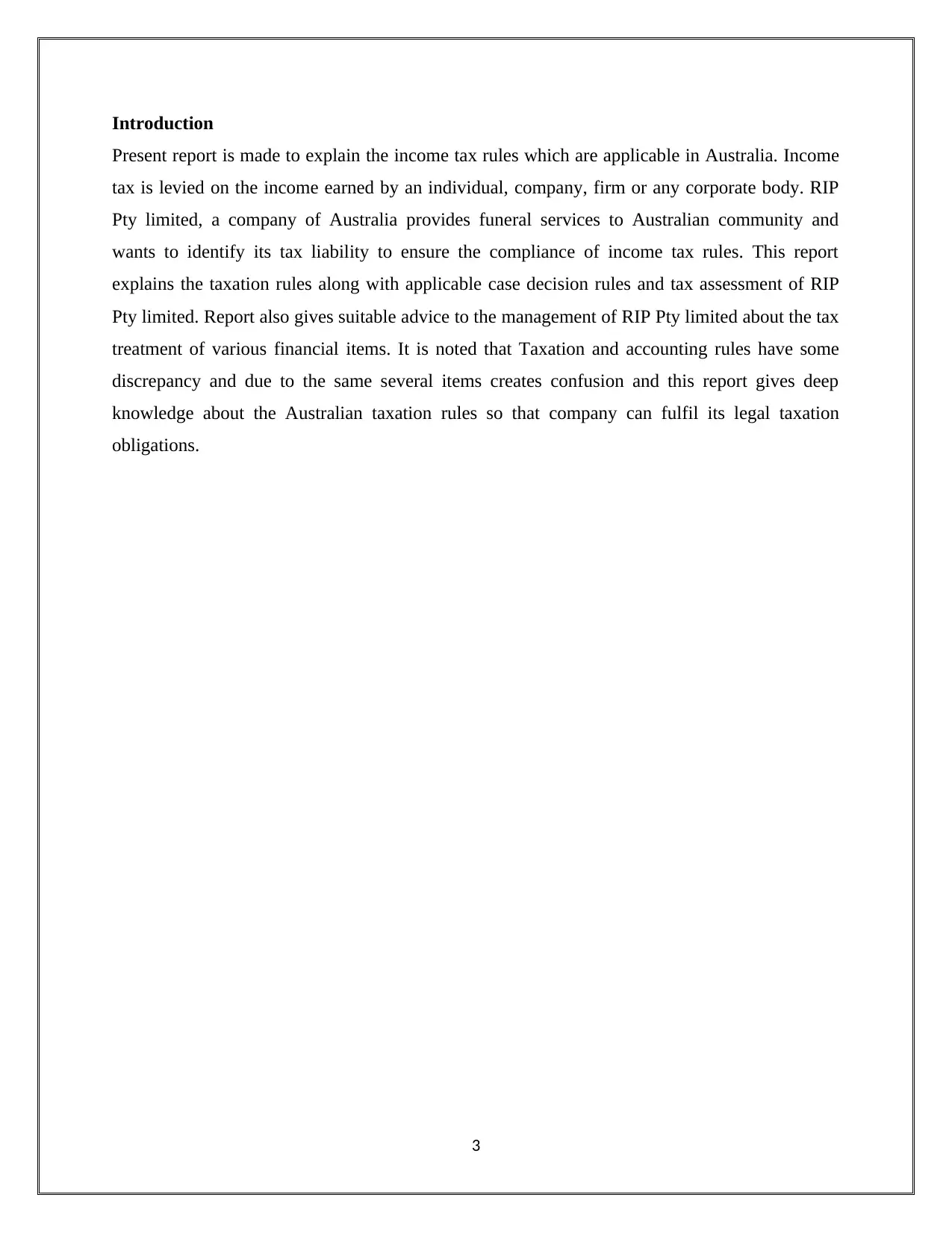
Introduction
Present report is made to explain the income tax rules which are applicable in Australia. Income
tax is levied on the income earned by an individual, company, firm or any corporate body. RIP
Pty limited, a company of Australia provides funeral services to Australian community and
wants to identify its tax liability to ensure the compliance of income tax rules. This report
explains the taxation rules along with applicable case decision rules and tax assessment of RIP
Pty limited. Report also gives suitable advice to the management of RIP Pty limited about the tax
treatment of various financial items. It is noted that Taxation and accounting rules have some
discrepancy and due to the same several items creates confusion and this report gives deep
knowledge about the Australian taxation rules so that company can fulfil its legal taxation
obligations.
3
Present report is made to explain the income tax rules which are applicable in Australia. Income
tax is levied on the income earned by an individual, company, firm or any corporate body. RIP
Pty limited, a company of Australia provides funeral services to Australian community and
wants to identify its tax liability to ensure the compliance of income tax rules. This report
explains the taxation rules along with applicable case decision rules and tax assessment of RIP
Pty limited. Report also gives suitable advice to the management of RIP Pty limited about the tax
treatment of various financial items. It is noted that Taxation and accounting rules have some
discrepancy and due to the same several items creates confusion and this report gives deep
knowledge about the Australian taxation rules so that company can fulfil its legal taxation
obligations.
3
⊘ This is a preview!⊘
Do you want full access?
Subscribe today to unlock all pages.

Trusted by 1+ million students worldwide
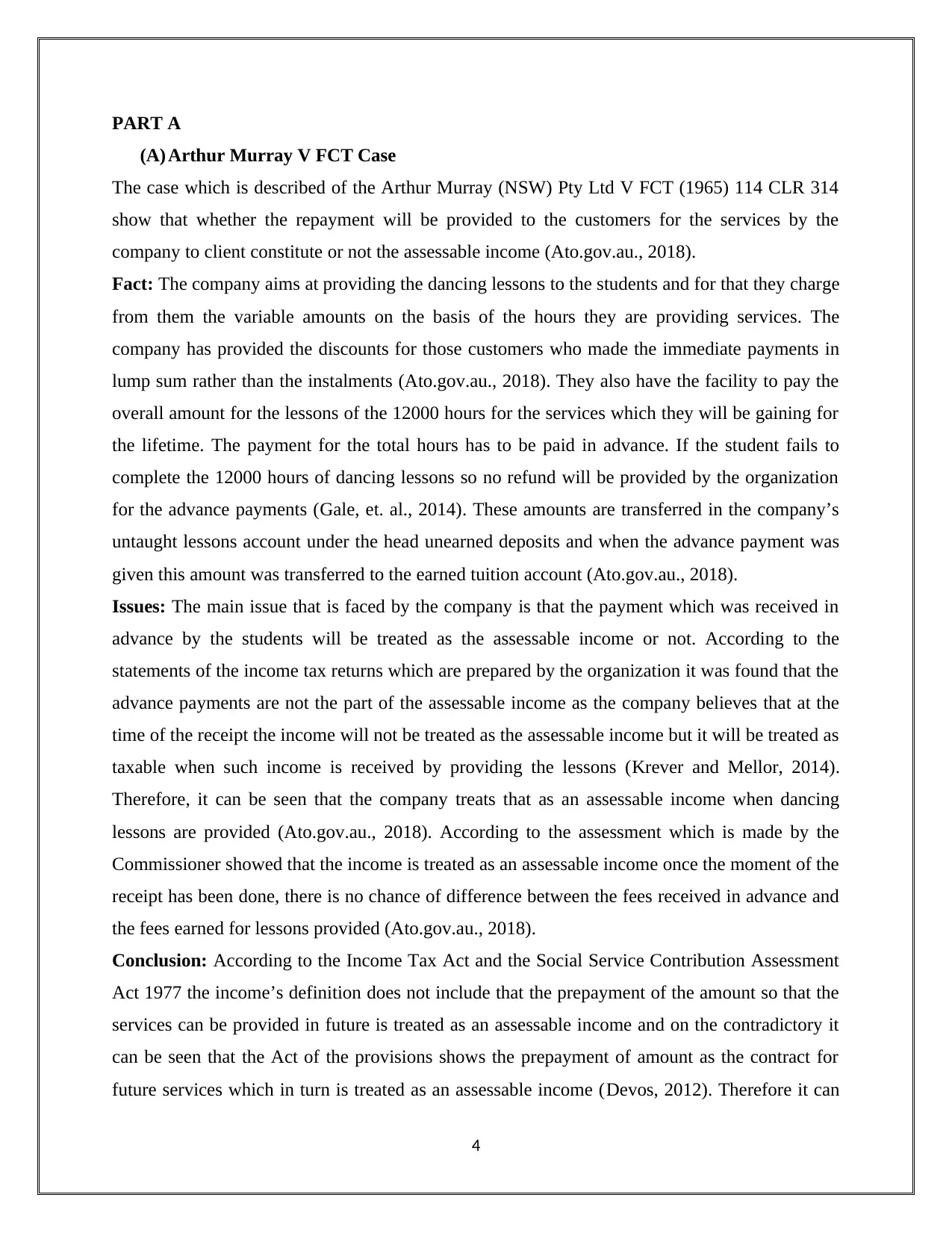
PART A
(A) Arthur Murray V FCT Case
The case which is described of the Arthur Murray (NSW) Pty Ltd V FCT (1965) 114 CLR 314
show that whether the repayment will be provided to the customers for the services by the
company to client constitute or not the assessable income (Ato.gov.au., 2018).
Fact: The company aims at providing the dancing lessons to the students and for that they charge
from them the variable amounts on the basis of the hours they are providing services. The
company has provided the discounts for those customers who made the immediate payments in
lump sum rather than the instalments (Ato.gov.au., 2018). They also have the facility to pay the
overall amount for the lessons of the 12000 hours for the services which they will be gaining for
the lifetime. The payment for the total hours has to be paid in advance. If the student fails to
complete the 12000 hours of dancing lessons so no refund will be provided by the organization
for the advance payments (Gale, et. al., 2014). These amounts are transferred in the company’s
untaught lessons account under the head unearned deposits and when the advance payment was
given this amount was transferred to the earned tuition account (Ato.gov.au., 2018).
Issues: The main issue that is faced by the company is that the payment which was received in
advance by the students will be treated as the assessable income or not. According to the
statements of the income tax returns which are prepared by the organization it was found that the
advance payments are not the part of the assessable income as the company believes that at the
time of the receipt the income will not be treated as the assessable income but it will be treated as
taxable when such income is received by providing the lessons (Krever and Mellor, 2014).
Therefore, it can be seen that the company treats that as an assessable income when dancing
lessons are provided (Ato.gov.au., 2018). According to the assessment which is made by the
Commissioner showed that the income is treated as an assessable income once the moment of the
receipt has been done, there is no chance of difference between the fees received in advance and
the fees earned for lessons provided (Ato.gov.au., 2018).
Conclusion: According to the Income Tax Act and the Social Service Contribution Assessment
Act 1977 the income’s definition does not include that the prepayment of the amount so that the
services can be provided in future is treated as an assessable income and on the contradictory it
can be seen that the Act of the provisions shows the prepayment of amount as the contract for
future services which in turn is treated as an assessable income (Devos, 2012). Therefore it can
4
(A) Arthur Murray V FCT Case
The case which is described of the Arthur Murray (NSW) Pty Ltd V FCT (1965) 114 CLR 314
show that whether the repayment will be provided to the customers for the services by the
company to client constitute or not the assessable income (Ato.gov.au., 2018).
Fact: The company aims at providing the dancing lessons to the students and for that they charge
from them the variable amounts on the basis of the hours they are providing services. The
company has provided the discounts for those customers who made the immediate payments in
lump sum rather than the instalments (Ato.gov.au., 2018). They also have the facility to pay the
overall amount for the lessons of the 12000 hours for the services which they will be gaining for
the lifetime. The payment for the total hours has to be paid in advance. If the student fails to
complete the 12000 hours of dancing lessons so no refund will be provided by the organization
for the advance payments (Gale, et. al., 2014). These amounts are transferred in the company’s
untaught lessons account under the head unearned deposits and when the advance payment was
given this amount was transferred to the earned tuition account (Ato.gov.au., 2018).
Issues: The main issue that is faced by the company is that the payment which was received in
advance by the students will be treated as the assessable income or not. According to the
statements of the income tax returns which are prepared by the organization it was found that the
advance payments are not the part of the assessable income as the company believes that at the
time of the receipt the income will not be treated as the assessable income but it will be treated as
taxable when such income is received by providing the lessons (Krever and Mellor, 2014).
Therefore, it can be seen that the company treats that as an assessable income when dancing
lessons are provided (Ato.gov.au., 2018). According to the assessment which is made by the
Commissioner showed that the income is treated as an assessable income once the moment of the
receipt has been done, there is no chance of difference between the fees received in advance and
the fees earned for lessons provided (Ato.gov.au., 2018).
Conclusion: According to the Income Tax Act and the Social Service Contribution Assessment
Act 1977 the income’s definition does not include that the prepayment of the amount so that the
services can be provided in future is treated as an assessable income and on the contradictory it
can be seen that the Act of the provisions shows the prepayment of amount as the contract for
future services which in turn is treated as an assessable income (Devos, 2012). Therefore it can
4
Paraphrase This Document
Need a fresh take? Get an instant paraphrase of this document with our AI Paraphraser
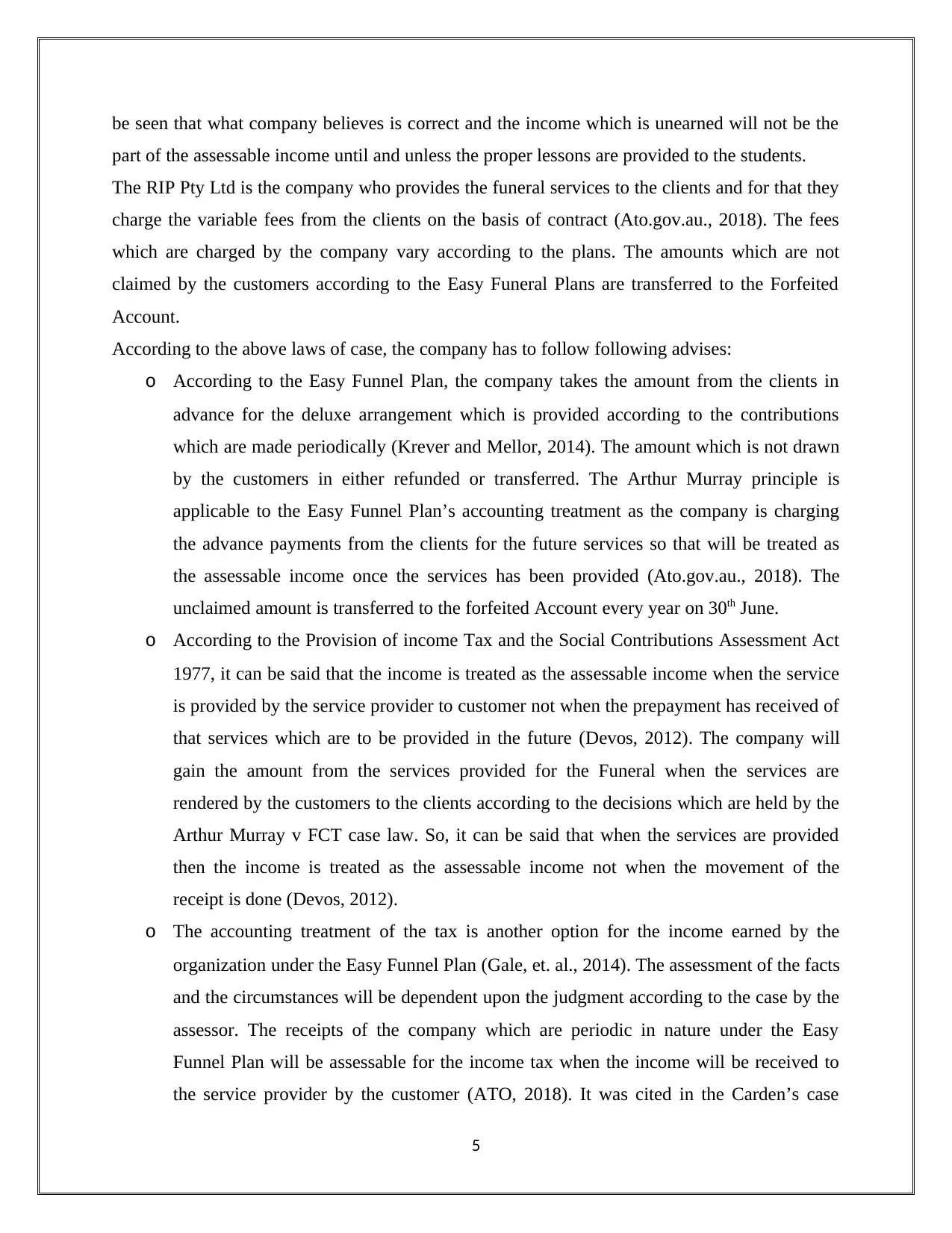
be seen that what company believes is correct and the income which is unearned will not be the
part of the assessable income until and unless the proper lessons are provided to the students.
The RIP Pty Ltd is the company who provides the funeral services to the clients and for that they
charge the variable fees from the clients on the basis of contract (Ato.gov.au., 2018). The fees
which are charged by the company vary according to the plans. The amounts which are not
claimed by the customers according to the Easy Funeral Plans are transferred to the Forfeited
Account.
According to the above laws of case, the company has to follow following advises:
o According to the Easy Funnel Plan, the company takes the amount from the clients in
advance for the deluxe arrangement which is provided according to the contributions
which are made periodically (Krever and Mellor, 2014). The amount which is not drawn
by the customers in either refunded or transferred. The Arthur Murray principle is
applicable to the Easy Funnel Plan’s accounting treatment as the company is charging
the advance payments from the clients for the future services so that will be treated as
the assessable income once the services has been provided (Ato.gov.au., 2018). The
unclaimed amount is transferred to the forfeited Account every year on 30th June.
o According to the Provision of income Tax and the Social Contributions Assessment Act
1977, it can be said that the income is treated as the assessable income when the service
is provided by the service provider to customer not when the prepayment has received of
that services which are to be provided in the future (Devos, 2012). The company will
gain the amount from the services provided for the Funeral when the services are
rendered by the customers to the clients according to the decisions which are held by the
Arthur Murray v FCT case law. So, it can be said that when the services are provided
then the income is treated as the assessable income not when the movement of the
receipt is done (Devos, 2012).
o The accounting treatment of the tax is another option for the income earned by the
organization under the Easy Funnel Plan (Gale, et. al., 2014). The assessment of the facts
and the circumstances will be dependent upon the judgment according to the case by the
assessor. The receipts of the company which are periodic in nature under the Easy
Funnel Plan will be assessable for the income tax when the income will be received to
the service provider by the customer (ATO, 2018). It was cited in the Carden’s case
5
part of the assessable income until and unless the proper lessons are provided to the students.
The RIP Pty Ltd is the company who provides the funeral services to the clients and for that they
charge the variable fees from the clients on the basis of contract (Ato.gov.au., 2018). The fees
which are charged by the company vary according to the plans. The amounts which are not
claimed by the customers according to the Easy Funeral Plans are transferred to the Forfeited
Account.
According to the above laws of case, the company has to follow following advises:
o According to the Easy Funnel Plan, the company takes the amount from the clients in
advance for the deluxe arrangement which is provided according to the contributions
which are made periodically (Krever and Mellor, 2014). The amount which is not drawn
by the customers in either refunded or transferred. The Arthur Murray principle is
applicable to the Easy Funnel Plan’s accounting treatment as the company is charging
the advance payments from the clients for the future services so that will be treated as
the assessable income once the services has been provided (Ato.gov.au., 2018). The
unclaimed amount is transferred to the forfeited Account every year on 30th June.
o According to the Provision of income Tax and the Social Contributions Assessment Act
1977, it can be said that the income is treated as the assessable income when the service
is provided by the service provider to customer not when the prepayment has received of
that services which are to be provided in the future (Devos, 2012). The company will
gain the amount from the services provided for the Funeral when the services are
rendered by the customers to the clients according to the decisions which are held by the
Arthur Murray v FCT case law. So, it can be said that when the services are provided
then the income is treated as the assessable income not when the movement of the
receipt is done (Devos, 2012).
o The accounting treatment of the tax is another option for the income earned by the
organization under the Easy Funnel Plan (Gale, et. al., 2014). The assessment of the facts
and the circumstances will be dependent upon the judgment according to the case by the
assessor. The receipts of the company which are periodic in nature under the Easy
Funnel Plan will be assessable for the income tax when the income will be received to
the service provider by the customer (ATO, 2018). It was cited in the Carden’s case
5
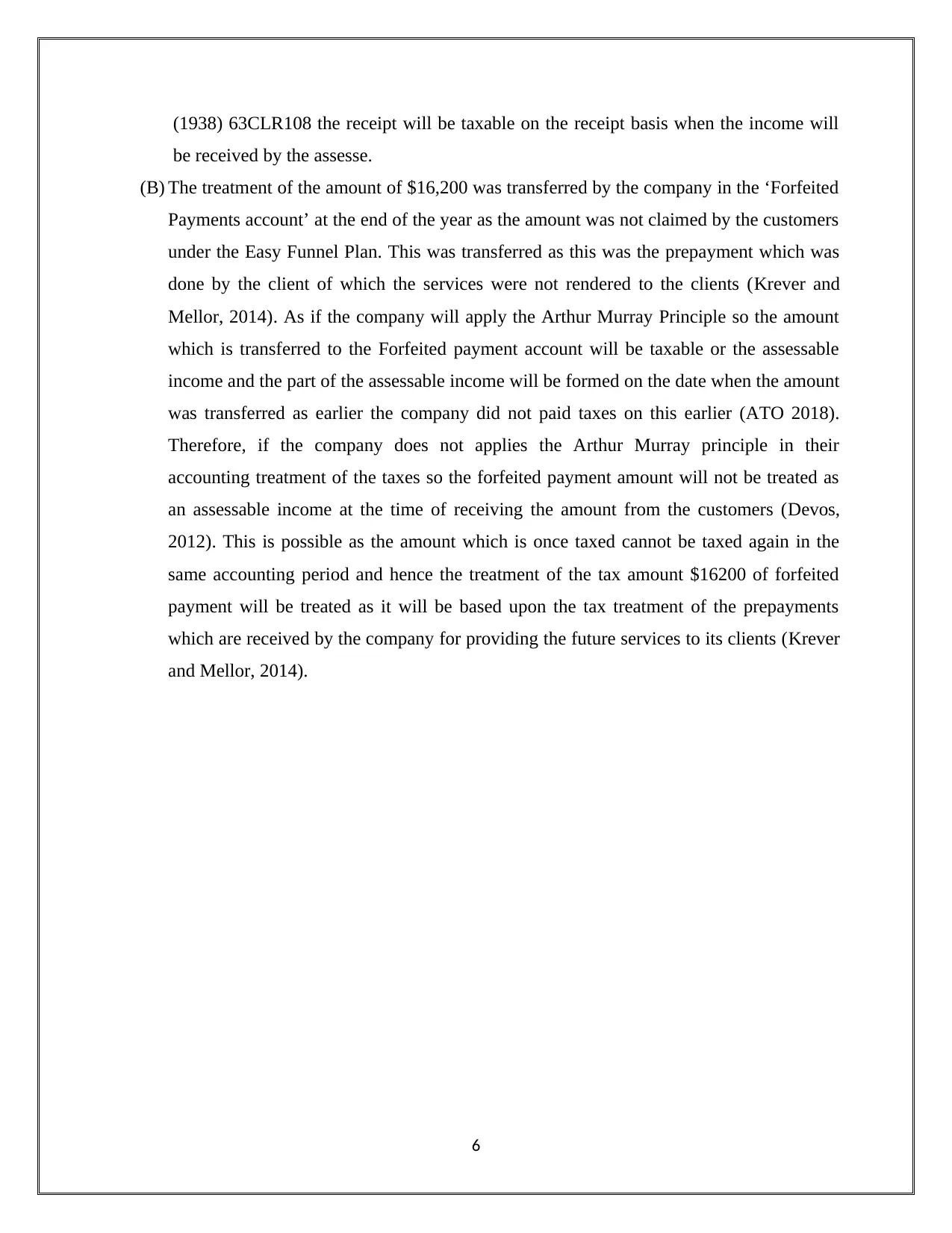
(1938) 63CLR108 the receipt will be taxable on the receipt basis when the income will
be received by the assesse.
(B) The treatment of the amount of $16,200 was transferred by the company in the ‘Forfeited
Payments account’ at the end of the year as the amount was not claimed by the customers
under the Easy Funnel Plan. This was transferred as this was the prepayment which was
done by the client of which the services were not rendered to the clients (Krever and
Mellor, 2014). As if the company will apply the Arthur Murray Principle so the amount
which is transferred to the Forfeited payment account will be taxable or the assessable
income and the part of the assessable income will be formed on the date when the amount
was transferred as earlier the company did not paid taxes on this earlier (ATO 2018).
Therefore, if the company does not applies the Arthur Murray principle in their
accounting treatment of the taxes so the forfeited payment amount will not be treated as
an assessable income at the time of receiving the amount from the customers (Devos,
2012). This is possible as the amount which is once taxed cannot be taxed again in the
same accounting period and hence the treatment of the tax amount $16200 of forfeited
payment will be treated as it will be based upon the tax treatment of the prepayments
which are received by the company for providing the future services to its clients (Krever
and Mellor, 2014).
6
be received by the assesse.
(B) The treatment of the amount of $16,200 was transferred by the company in the ‘Forfeited
Payments account’ at the end of the year as the amount was not claimed by the customers
under the Easy Funnel Plan. This was transferred as this was the prepayment which was
done by the client of which the services were not rendered to the clients (Krever and
Mellor, 2014). As if the company will apply the Arthur Murray Principle so the amount
which is transferred to the Forfeited payment account will be taxable or the assessable
income and the part of the assessable income will be formed on the date when the amount
was transferred as earlier the company did not paid taxes on this earlier (ATO 2018).
Therefore, if the company does not applies the Arthur Murray principle in their
accounting treatment of the taxes so the forfeited payment amount will not be treated as
an assessable income at the time of receiving the amount from the customers (Devos,
2012). This is possible as the amount which is once taxed cannot be taxed again in the
same accounting period and hence the treatment of the tax amount $16200 of forfeited
payment will be treated as it will be based upon the tax treatment of the prepayments
which are received by the company for providing the future services to its clients (Krever
and Mellor, 2014).
6
⊘ This is a preview!⊘
Do you want full access?
Subscribe today to unlock all pages.

Trusted by 1+ million students worldwide
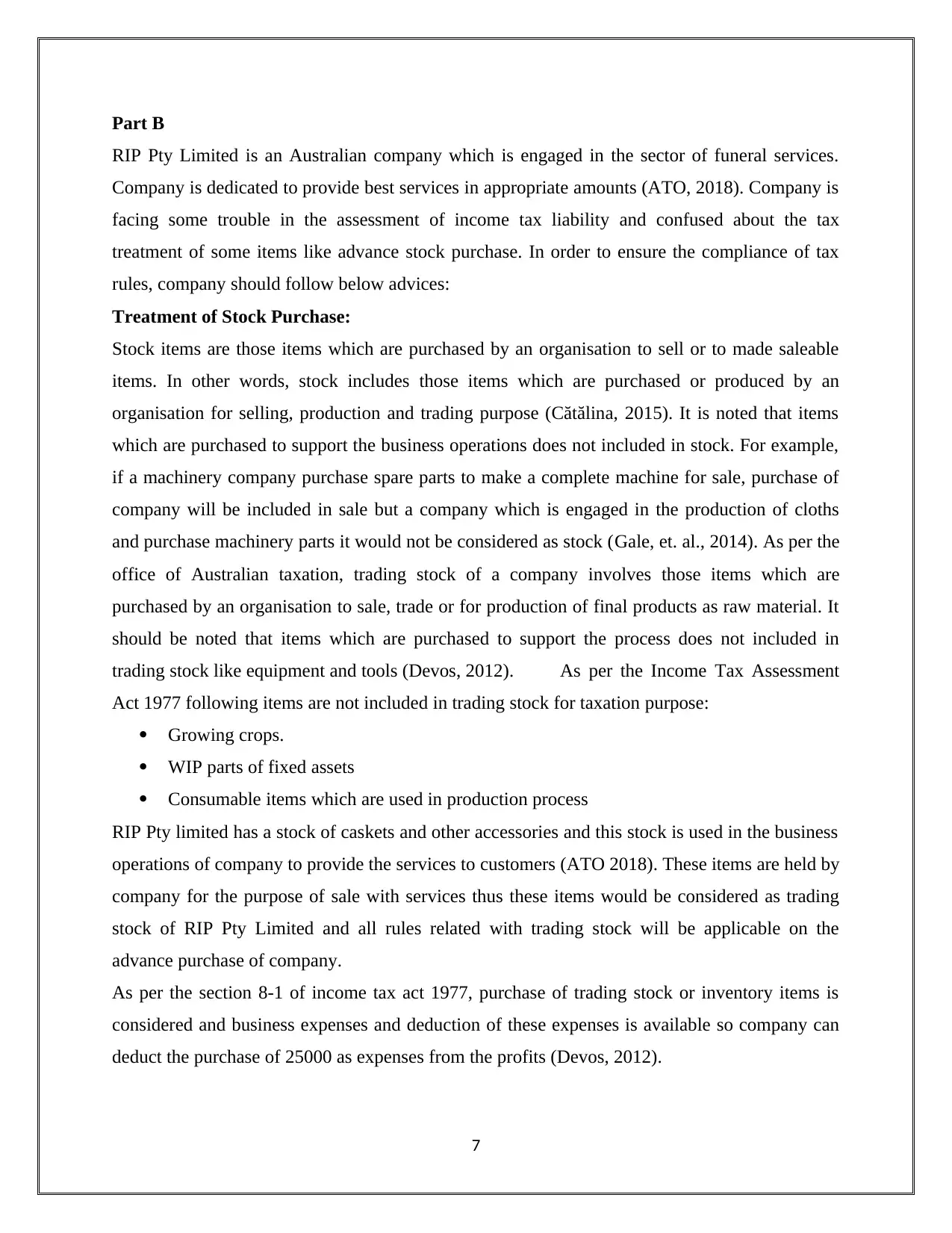
Part B
RIP Pty Limited is an Australian company which is engaged in the sector of funeral services.
Company is dedicated to provide best services in appropriate amounts (ATO, 2018). Company is
facing some trouble in the assessment of income tax liability and confused about the tax
treatment of some items like advance stock purchase. In order to ensure the compliance of tax
rules, company should follow below advices:
Treatment of Stock Purchase:
Stock items are those items which are purchased by an organisation to sell or to made saleable
items. In other words, stock includes those items which are purchased or produced by an
organisation for selling, production and trading purpose (Cătălina, 2015). It is noted that items
which are purchased to support the business operations does not included in stock. For example,
if a machinery company purchase spare parts to make a complete machine for sale, purchase of
company will be included in sale but a company which is engaged in the production of cloths
and purchase machinery parts it would not be considered as stock (Gale, et. al., 2014). As per the
office of Australian taxation, trading stock of a company involves those items which are
purchased by an organisation to sale, trade or for production of final products as raw material. It
should be noted that items which are purchased to support the process does not included in
trading stock like equipment and tools (Devos, 2012). As per the Income Tax Assessment
Act 1977 following items are not included in trading stock for taxation purpose:
Growing crops.
WIP parts of fixed assets
Consumable items which are used in production process
RIP Pty limited has a stock of caskets and other accessories and this stock is used in the business
operations of company to provide the services to customers (ATO 2018). These items are held by
company for the purpose of sale with services thus these items would be considered as trading
stock of RIP Pty Limited and all rules related with trading stock will be applicable on the
advance purchase of company.
As per the section 8-1 of income tax act 1977, purchase of trading stock or inventory items is
considered and business expenses and deduction of these expenses is available so company can
deduct the purchase of 25000 as expenses from the profits (Devos, 2012).
7
RIP Pty Limited is an Australian company which is engaged in the sector of funeral services.
Company is dedicated to provide best services in appropriate amounts (ATO, 2018). Company is
facing some trouble in the assessment of income tax liability and confused about the tax
treatment of some items like advance stock purchase. In order to ensure the compliance of tax
rules, company should follow below advices:
Treatment of Stock Purchase:
Stock items are those items which are purchased by an organisation to sell or to made saleable
items. In other words, stock includes those items which are purchased or produced by an
organisation for selling, production and trading purpose (Cătălina, 2015). It is noted that items
which are purchased to support the business operations does not included in stock. For example,
if a machinery company purchase spare parts to make a complete machine for sale, purchase of
company will be included in sale but a company which is engaged in the production of cloths
and purchase machinery parts it would not be considered as stock (Gale, et. al., 2014). As per the
office of Australian taxation, trading stock of a company involves those items which are
purchased by an organisation to sale, trade or for production of final products as raw material. It
should be noted that items which are purchased to support the process does not included in
trading stock like equipment and tools (Devos, 2012). As per the Income Tax Assessment
Act 1977 following items are not included in trading stock for taxation purpose:
Growing crops.
WIP parts of fixed assets
Consumable items which are used in production process
RIP Pty limited has a stock of caskets and other accessories and this stock is used in the business
operations of company to provide the services to customers (ATO 2018). These items are held by
company for the purpose of sale with services thus these items would be considered as trading
stock of RIP Pty Limited and all rules related with trading stock will be applicable on the
advance purchase of company.
As per the section 8-1 of income tax act 1977, purchase of trading stock or inventory items is
considered and business expenses and deduction of these expenses is available so company can
deduct the purchase of 25000 as expenses from the profits (Devos, 2012).
7
Paraphrase This Document
Need a fresh take? Get an instant paraphrase of this document with our AI Paraphraser
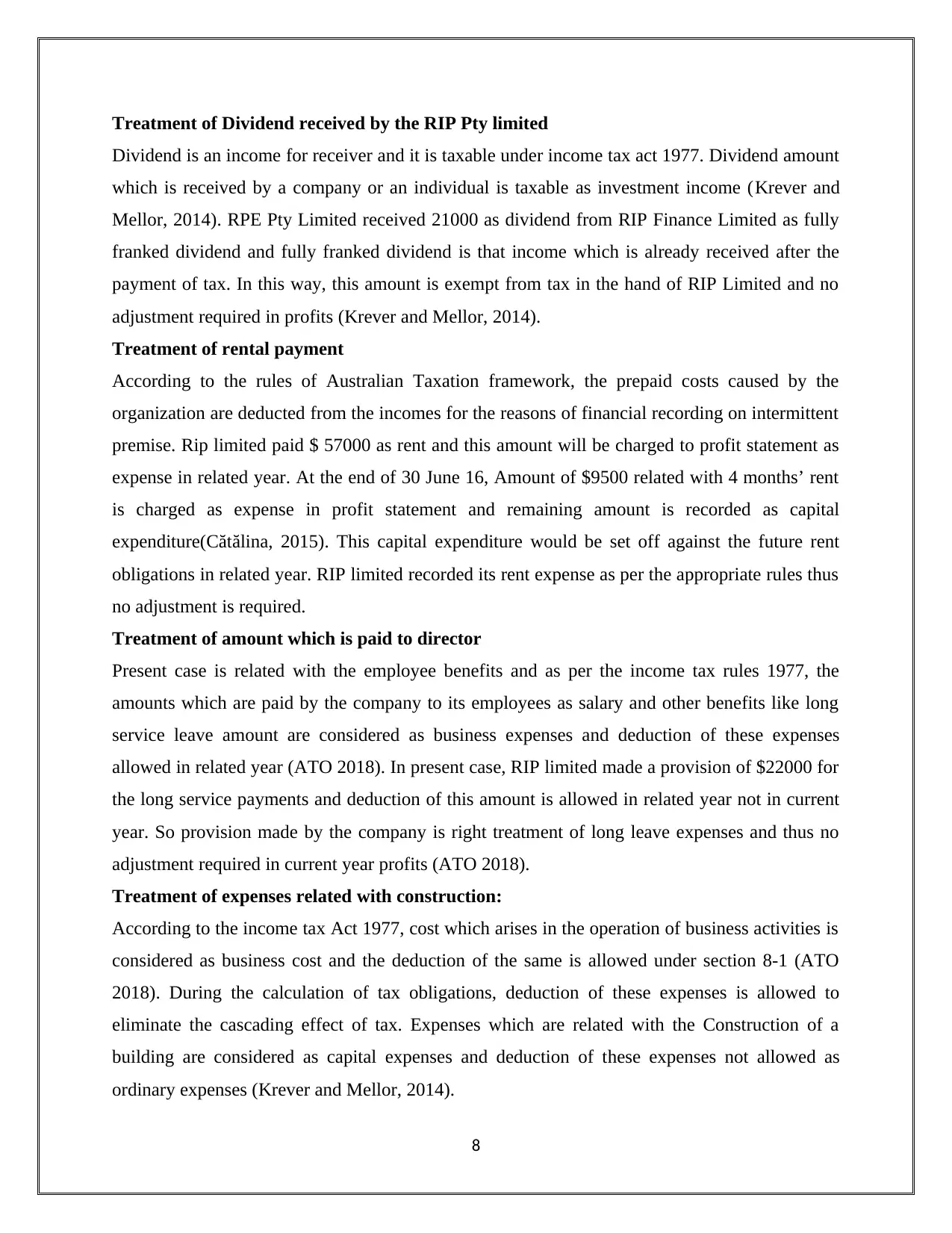
Treatment of Dividend received by the RIP Pty limited
Dividend is an income for receiver and it is taxable under income tax act 1977. Dividend amount
which is received by a company or an individual is taxable as investment income (Krever and
Mellor, 2014). RPE Pty Limited received 21000 as dividend from RIP Finance Limited as fully
franked dividend and fully franked dividend is that income which is already received after the
payment of tax. In this way, this amount is exempt from tax in the hand of RIP Limited and no
adjustment required in profits (Krever and Mellor, 2014).
Treatment of rental payment
According to the rules of Australian Taxation framework, the prepaid costs caused by the
organization are deducted from the incomes for the reasons of financial recording on intermittent
premise. Rip limited paid $ 57000 as rent and this amount will be charged to profit statement as
expense in related year. At the end of 30 June 16, Amount of $9500 related with 4 months’ rent
is charged as expense in profit statement and remaining amount is recorded as capital
expenditure(Cătălina, 2015). This capital expenditure would be set off against the future rent
obligations in related year. RIP limited recorded its rent expense as per the appropriate rules thus
no adjustment is required.
Treatment of amount which is paid to director
Present case is related with the employee benefits and as per the income tax rules 1977, the
amounts which are paid by the company to its employees as salary and other benefits like long
service leave amount are considered as business expenses and deduction of these expenses
allowed in related year (ATO 2018). In present case, RIP limited made a provision of $22000 for
the long service payments and deduction of this amount is allowed in related year not in current
year. So provision made by the company is right treatment of long leave expenses and thus no
adjustment required in current year profits (ATO 2018).
Treatment of expenses related with construction:
According to the income tax Act 1977, cost which arises in the operation of business activities is
considered as business cost and the deduction of the same is allowed under section 8-1 (ATO
2018). During the calculation of tax obligations, deduction of these expenses is allowed to
eliminate the cascading effect of tax. Expenses which are related with the Construction of a
building are considered as capital expenses and deduction of these expenses not allowed as
ordinary expenses (Krever and Mellor, 2014).
8
Dividend is an income for receiver and it is taxable under income tax act 1977. Dividend amount
which is received by a company or an individual is taxable as investment income (Krever and
Mellor, 2014). RPE Pty Limited received 21000 as dividend from RIP Finance Limited as fully
franked dividend and fully franked dividend is that income which is already received after the
payment of tax. In this way, this amount is exempt from tax in the hand of RIP Limited and no
adjustment required in profits (Krever and Mellor, 2014).
Treatment of rental payment
According to the rules of Australian Taxation framework, the prepaid costs caused by the
organization are deducted from the incomes for the reasons of financial recording on intermittent
premise. Rip limited paid $ 57000 as rent and this amount will be charged to profit statement as
expense in related year. At the end of 30 June 16, Amount of $9500 related with 4 months’ rent
is charged as expense in profit statement and remaining amount is recorded as capital
expenditure(Cătălina, 2015). This capital expenditure would be set off against the future rent
obligations in related year. RIP limited recorded its rent expense as per the appropriate rules thus
no adjustment is required.
Treatment of amount which is paid to director
Present case is related with the employee benefits and as per the income tax rules 1977, the
amounts which are paid by the company to its employees as salary and other benefits like long
service leave amount are considered as business expenses and deduction of these expenses
allowed in related year (ATO 2018). In present case, RIP limited made a provision of $22000 for
the long service payments and deduction of this amount is allowed in related year not in current
year. So provision made by the company is right treatment of long leave expenses and thus no
adjustment required in current year profits (ATO 2018).
Treatment of expenses related with construction:
According to the income tax Act 1977, cost which arises in the operation of business activities is
considered as business cost and the deduction of the same is allowed under section 8-1 (ATO
2018). During the calculation of tax obligations, deduction of these expenses is allowed to
eliminate the cascading effect of tax. Expenses which are related with the Construction of a
building are considered as capital expenses and deduction of these expenses not allowed as
ordinary expenses (Krever and Mellor, 2014).
8
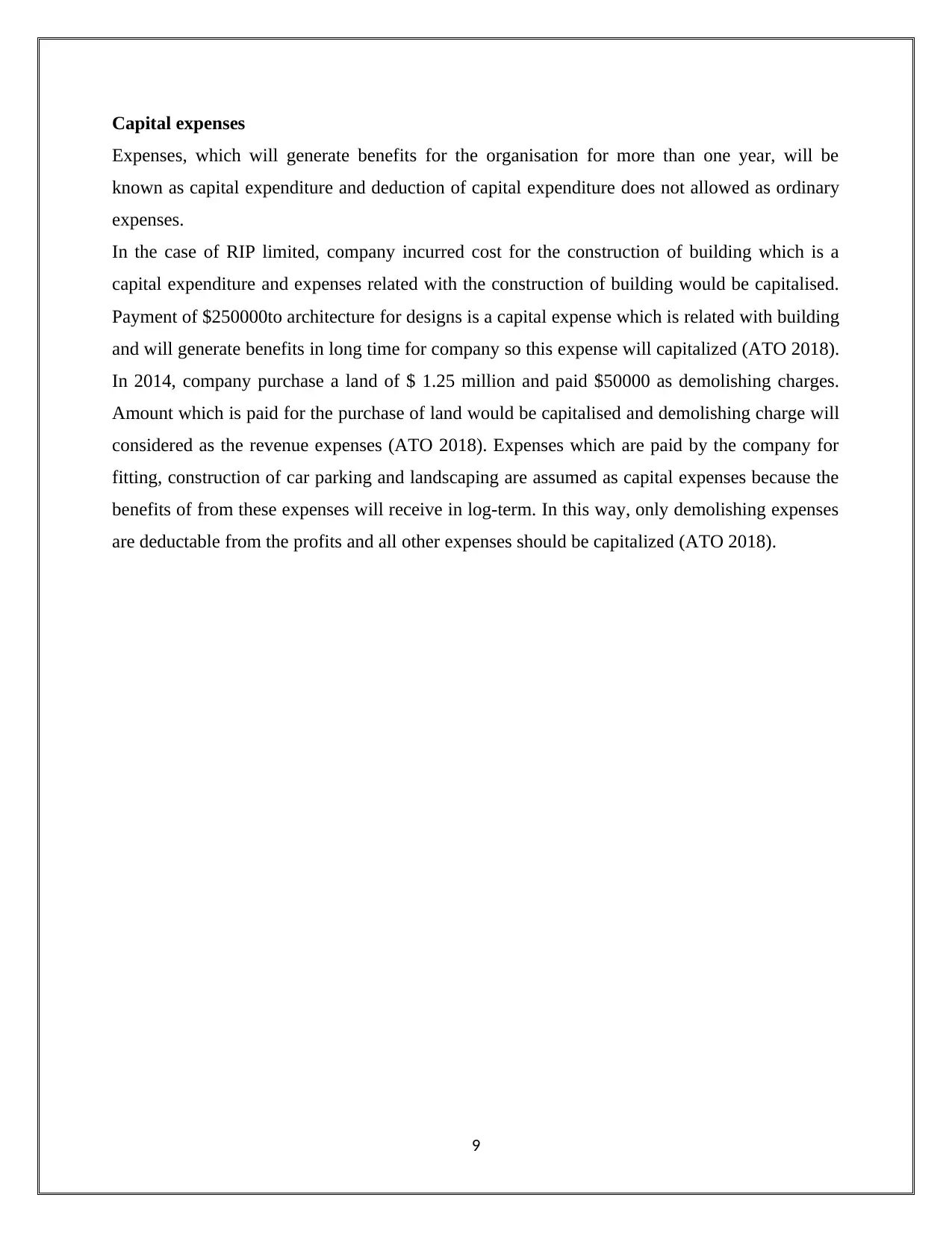
Capital expenses
Expenses, which will generate benefits for the organisation for more than one year, will be
known as capital expenditure and deduction of capital expenditure does not allowed as ordinary
expenses.
In the case of RIP limited, company incurred cost for the construction of building which is a
capital expenditure and expenses related with the construction of building would be capitalised.
Payment of $250000to architecture for designs is a capital expense which is related with building
and will generate benefits in long time for company so this expense will capitalized (ATO 2018).
In 2014, company purchase a land of $ 1.25 million and paid $50000 as demolishing charges.
Amount which is paid for the purchase of land would be capitalised and demolishing charge will
considered as the revenue expenses (ATO 2018). Expenses which are paid by the company for
fitting, construction of car parking and landscaping are assumed as capital expenses because the
benefits of from these expenses will receive in log-term. In this way, only demolishing expenses
are deductable from the profits and all other expenses should be capitalized (ATO 2018).
9
Expenses, which will generate benefits for the organisation for more than one year, will be
known as capital expenditure and deduction of capital expenditure does not allowed as ordinary
expenses.
In the case of RIP limited, company incurred cost for the construction of building which is a
capital expenditure and expenses related with the construction of building would be capitalised.
Payment of $250000to architecture for designs is a capital expense which is related with building
and will generate benefits in long time for company so this expense will capitalized (ATO 2018).
In 2014, company purchase a land of $ 1.25 million and paid $50000 as demolishing charges.
Amount which is paid for the purchase of land would be capitalised and demolishing charge will
considered as the revenue expenses (ATO 2018). Expenses which are paid by the company for
fitting, construction of car parking and landscaping are assumed as capital expenses because the
benefits of from these expenses will receive in log-term. In this way, only demolishing expenses
are deductable from the profits and all other expenses should be capitalized (ATO 2018).
9
⊘ This is a preview!⊘
Do you want full access?
Subscribe today to unlock all pages.

Trusted by 1+ million students worldwide
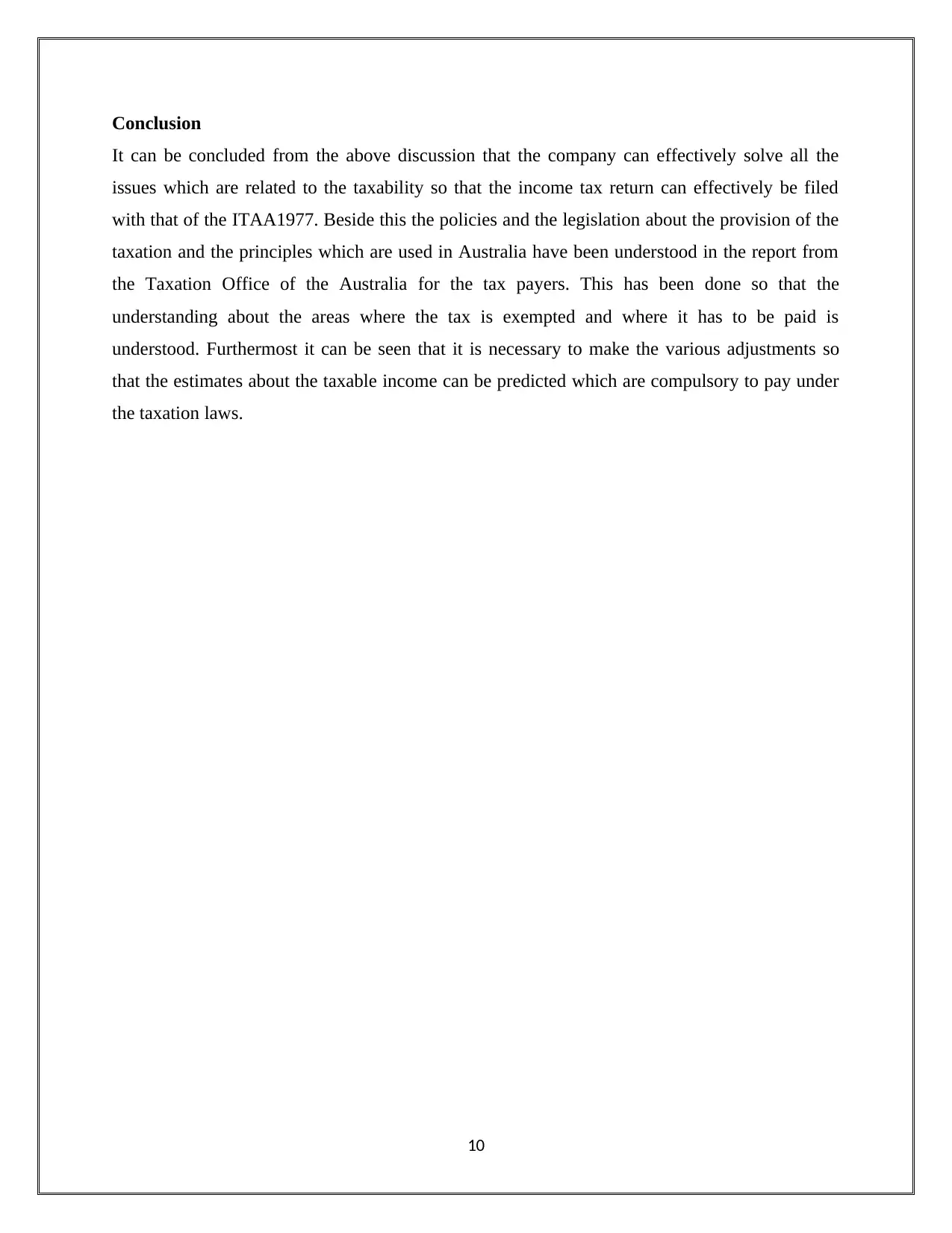
Conclusion
It can be concluded from the above discussion that the company can effectively solve all the
issues which are related to the taxability so that the income tax return can effectively be filed
with that of the ITAA1977. Beside this the policies and the legislation about the provision of the
taxation and the principles which are used in Australia have been understood in the report from
the Taxation Office of the Australia for the tax payers. This has been done so that the
understanding about the areas where the tax is exempted and where it has to be paid is
understood. Furthermost it can be seen that it is necessary to make the various adjustments so
that the estimates about the taxable income can be predicted which are compulsory to pay under
the taxation laws.
10
It can be concluded from the above discussion that the company can effectively solve all the
issues which are related to the taxability so that the income tax return can effectively be filed
with that of the ITAA1977. Beside this the policies and the legislation about the provision of the
taxation and the principles which are used in Australia have been understood in the report from
the Taxation Office of the Australia for the tax payers. This has been done so that the
understanding about the areas where the tax is exempted and where it has to be paid is
understood. Furthermost it can be seen that it is necessary to make the various adjustments so
that the estimates about the taxable income can be predicted which are compulsory to pay under
the taxation laws.
10
Paraphrase This Document
Need a fresh take? Get an instant paraphrase of this document with our AI Paraphraser
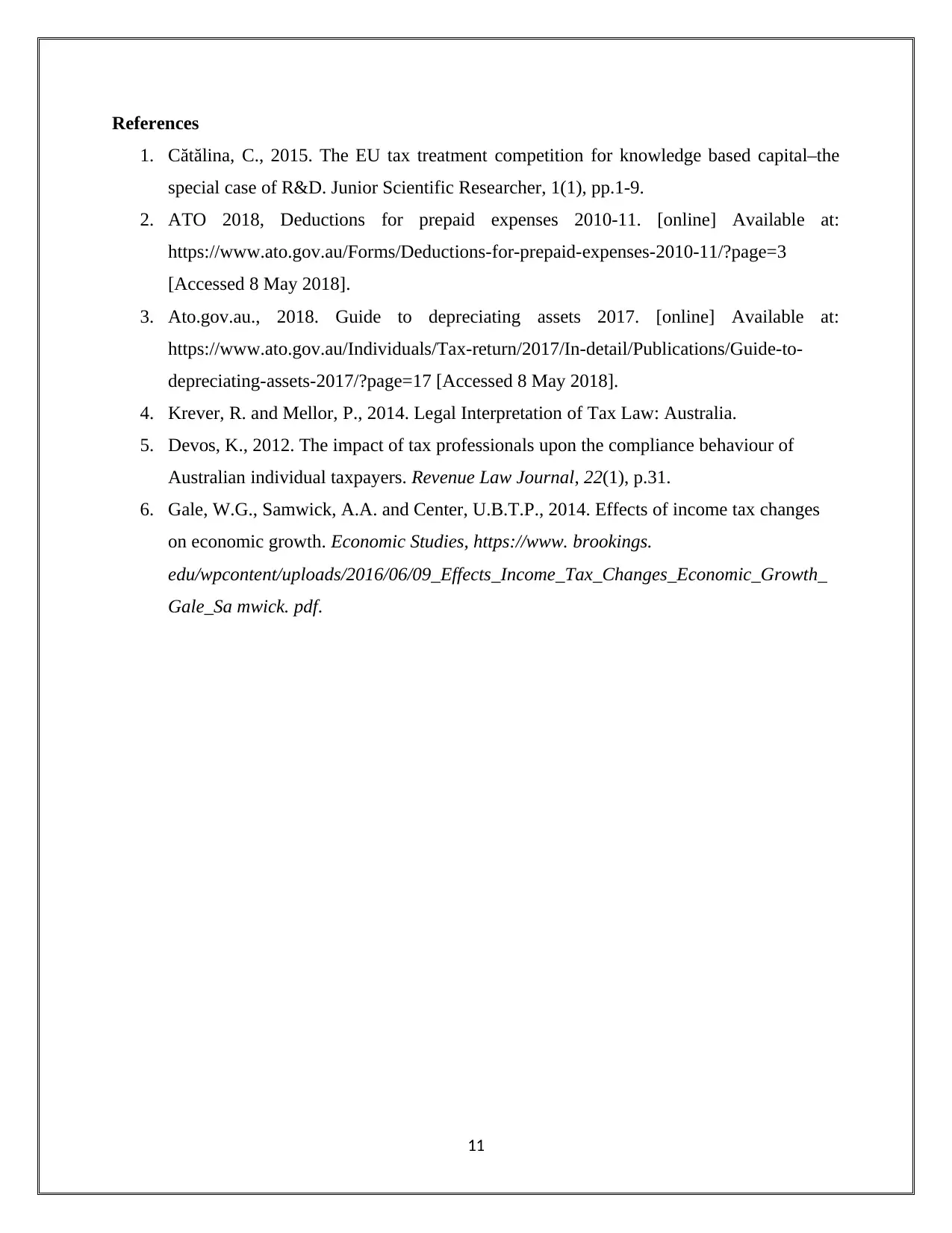
References
1. Cătălina, C., 2015. The EU tax treatment competition for knowledge based capital–the
special case of R&D. Junior Scientific Researcher, 1(1), pp.1-9.
2. ATO 2018, Deductions for prepaid expenses 2010-11. [online] Available at:
https://www.ato.gov.au/Forms/Deductions-for-prepaid-expenses-2010-11/?page=3
[Accessed 8 May 2018].
3. Ato.gov.au., 2018. Guide to depreciating assets 2017. [online] Available at:
https://www.ato.gov.au/Individuals/Tax-return/2017/In-detail/Publications/Guide-to-
depreciating-assets-2017/?page=17 [Accessed 8 May 2018].
4. Krever, R. and Mellor, P., 2014. Legal Interpretation of Tax Law: Australia.
5. Devos, K., 2012. The impact of tax professionals upon the compliance behaviour of
Australian individual taxpayers. Revenue Law Journal, 22(1), p.31.
6. Gale, W.G., Samwick, A.A. and Center, U.B.T.P., 2014. Effects of income tax changes
on economic growth. Economic Studies, https://www. brookings.
edu/wpcontent/uploads/2016/06/09_Effects_Income_Tax_Changes_Economic_Growth_
Gale_Sa mwick. pdf.
11
1. Cătălina, C., 2015. The EU tax treatment competition for knowledge based capital–the
special case of R&D. Junior Scientific Researcher, 1(1), pp.1-9.
2. ATO 2018, Deductions for prepaid expenses 2010-11. [online] Available at:
https://www.ato.gov.au/Forms/Deductions-for-prepaid-expenses-2010-11/?page=3
[Accessed 8 May 2018].
3. Ato.gov.au., 2018. Guide to depreciating assets 2017. [online] Available at:
https://www.ato.gov.au/Individuals/Tax-return/2017/In-detail/Publications/Guide-to-
depreciating-assets-2017/?page=17 [Accessed 8 May 2018].
4. Krever, R. and Mellor, P., 2014. Legal Interpretation of Tax Law: Australia.
5. Devos, K., 2012. The impact of tax professionals upon the compliance behaviour of
Australian individual taxpayers. Revenue Law Journal, 22(1), p.31.
6. Gale, W.G., Samwick, A.A. and Center, U.B.T.P., 2014. Effects of income tax changes
on economic growth. Economic Studies, https://www. brookings.
edu/wpcontent/uploads/2016/06/09_Effects_Income_Tax_Changes_Economic_Growth_
Gale_Sa mwick. pdf.
11
1 out of 11
Related Documents
Your All-in-One AI-Powered Toolkit for Academic Success.
+13062052269
info@desklib.com
Available 24*7 on WhatsApp / Email
![[object Object]](/_next/static/media/star-bottom.7253800d.svg)
Unlock your academic potential
Copyright © 2020–2026 A2Z Services. All Rights Reserved. Developed and managed by ZUCOL.





